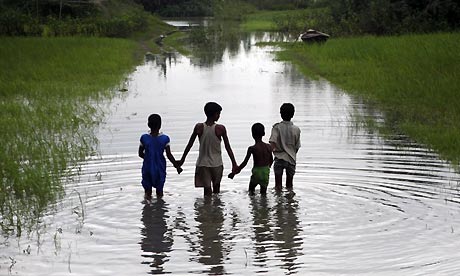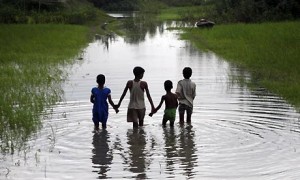
Global Warming Makes Solving the 21st Century’s Problems Much Harder
This post is cross-posted from the National Journal’s Energy Experts blog. This week’s question was: “Is Global Warming the Planet’s Biggest Problem?” My answer is below.
 On first glance, a rise of two degrees Celsius in average temperature does not appear to be intrinsically harmful. That is the difference between the average temperature of New York and of Boston. A four degree Celsius rise – widely seen as a harbinger of global disaster – is still only the difference between Boston and Washington’s average annual temperature.
On first glance, a rise of two degrees Celsius in average temperature does not appear to be intrinsically harmful. That is the difference between the average temperature of New York and of Boston. A four degree Celsius rise – widely seen as a harbinger of global disaster – is still only the difference between Boston and Washington’s average annual temperature.
Problems like a lack of economic growth, endemic disease, hunger, and fresh water availability are a greater challenge to human security than simply a rise in temperature of 2 or 4 degrees in average temperature. Terrorism, nuclear proliferation, and resource wars would seem to pose a greater threat to global security than just a difference of 2 degrees in average temperature.
Unfortunately, climate change is what we call a ‘ring road’ issue; meaning that climate change affects all of these other threats. Unchecked, a warming of only 2 degrees Celsius will have significant impacts on water, food, and energy security. It will change disease vectors. It will drive migration. These changes, in turn, could affect state stability and harm global security.
As an example of the ‘ring road’ effects, today the American Security Project is hosting a conference on Bangladesh, at which both American and Bangladeshi experts have discussed the diverse challenges facing Bangladesh over the coming years. And they are many: economic development is intertwined with workers’ rights and garment manufacturing; there is a growing threat of terrorism as Bangladeshi nationals return from war in Afghanistan; there are great power rivalries in the Bay of Bengal between China, India, and the United States. However, all of that is threatened by climate change. Rising sea levels threaten to make the homes of over 20 million people in Bangladesh uninhabitable. Changing ice melt from the Himalayas threaten the flow of water down the Brahmaputra and Ganges rivers, leading to greater floods in the monsoon season and drought in dry season. These changes will lead to migration, both internally and externally. Climate change will make all of the problems facing Bangladesh more difficult.
It is not an exaggeration to say that climate change could make solving the other problems the world faces impossible. Climate change is rightly termed as a “threat multiplier” or an “accelerant of instability.” Therefore, it is not quite accurate to say that global warming is the planet’s biggest problem: it is the effects of global warming, and the effects of the effects that really make it a threat. If we do not effectively address climate change, then it is clear that we will not be able to address the other challenges of the 21st Century – and there are many.
Climate change is a security threat, not because a rise of 2 degrees will be intrinsically harmful, but because of the implications it has that it will impose on water, food, and energy. So, while it may have a third degree impact, it is impossible to separate climate change from the other problems. The impacts of the impacts of climate change are what make addressing climate change (through both reducing emissions and increasing resiliency) the defining challenge of the first half of the 21st Century.






[…] Global Warming Makes Solving the 21st Century Problems Much Harder […]
[…] Intergovernmental Panel on Climate Change has recently released their Fifth Assessment: the newest installment outlining the projected short and long term consequences of climate […]